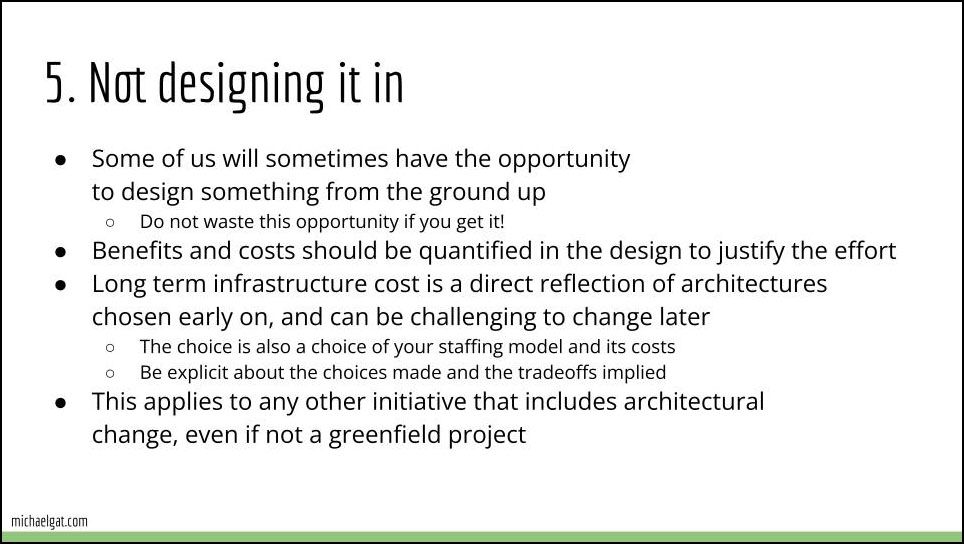Anti-Patterns in Tech Cost Management: Not designing it in
Series Index
Introduction
Anti-Pattern 1: Not considering scale
Anti-Pattern 2: Bad cloud strategy
Anti-Pattern 3: Inability to assign/attribute costs
Anti-Pattern 4: No metrics or bad metrics
Anti-Pattern 5: Not designing it in
Anti-Pattern 6: Cost management as a standalone
Anti-Pattern 7/8: No ongoing reviews (current and potential)
Anti-Pattern 9: Across the board cuts
Anti-Pattern 10: “A tool will solve the problem!”
Anti-Pattern Bonus: Don’t do rewards programs!
A few thoughts: Three things you can do right now, for yourself and your team
Wrap up

Most of us, at some point in our careers, will have the opportunity to design something from the ground up. Even if we don’t, we will work on projects that involve architectural change and/or complete re-architecture. This is an opportunity to address costs that should not be missed.
Many of the previous slides come into play in this one, for obvious reasons. Architecture/re-architecture is when you will get the opportunity to ensure that the right metrics are being applied and collected. They are when you can decide up-front how to attribute costs and ensure you’ve set up the right structures to do that. They may even be the point where you can and should consider a change to the cloud strategy. At the highest level, re-architecture may be about significant changes in scale that should give you pause.
Yet, time and time again, I’ve seen companies go through a full re-architecture and only think about costs as an afterthought.
A company I worked for a few years back in the fintech space comes to mind. The platforms and systems had become harder and harder to manage as the company had grown. Their choice to use cloud as a datacenter had clearly hurt them. They had made sensible — at the time — choices for how to store data that years later meant running massive and underutilized clusters just to provide sufficient direct-attached storage for the amounts of data they had grown to deal with. This worked well when their target market was “smaller naive users,” who liked them for ease-of-use. But as they grew to focus on enterprise customers, they found that their costs were high compared to larger competitors who were doing the same thing with mainframes.
And yet, when they announced a new v2, which was to be a ground-up re-architecture, many of the same problems remained. They would still use the same or similar internal platforms. Their cloud strategy would remain “cloud neutral.” They wouldn’t use any higher-level cloud products. Frequently in the dozen-page long high-level strategy for this re-architecture, they mentioned costs as a reason for what they were doing, but nowhere did they specify what changes they would make from the top to address structural issues.
This, along with the problems in the next and 9th slide, are why I decided the role was wrong, and left after only six months.
Join us at the SoCal Linux Expo (SCaLE 21x) in Pasadena on March 14-17. My talk will be on Saturday the 16th. I will also be speaking at UpSCaLE on Friday night, and running the Observability track on Saturday and Sunday.
It’s $90 for four days of great content. (If you know me, ping me as I may have a few discount passes left.)